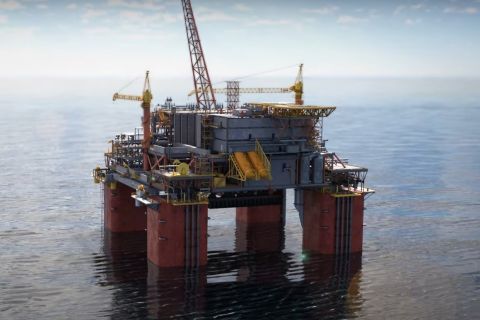Oil prices rose on Nov. 12, reversing early losses on hopes that President Donald Trump may signal progress on trade talks with China in a speech later in the day.
Brent crude futures were up 31 cents, or 0.5%, at $62.49 a barrel by 0644 GMT, after dipping to as low as $61.90 earlier in the day.
U.S. West Texas Intermediate (WTI) crude was up 23 cents, or 0.4%, at $57.09 a barrel, having fallen to $56.55.
Worries about the impact on oil demand from the fallout of the 16-month U.S.-China trade war, which has weighed on global economic growth, sent prices lower on Nov. 11.
Trump said on Nov. 9 that talks with China were moving along "very nicely" but the United States would only make a deal if it was the right one for Washington. He also there had been incorrect reporting about U.S. willingness to lift tariffs.
Trump speaks to the Economic Club of New York later on Nov. 12, and markets will be keen for any update on the talks.
"Positive commentary about a possible U.S. and China interim trade deal certainly helps, but the fundamentals are supportive," said Virendra Chauhan, oil analyst at Energy Aspects in Singapore, pointing to an improved demand outlook.
"Six million barrels per day (bbl/d) of refining capacity is due to return from turnarounds across November and December," he said.
On the supply side, Goldman Sachs also cut its 2020 forecast for growth in U.S. oil production, which has surged in recent years.
The investment bank cut its growth forecast for next year by 100,000 bbl/d to 600,000 bbl/d over 2019.
"We expect U.S. oil growth to decelerate into 2020 as many companies look to balance growth with capex," Goldman Sachs said.
Elsewhere, U.S. data showed that crude inventories at Cushing, the delivery point for WTI, fell about 1.2 MMbbl in the week to Nov. 8, traders said, citing market intelligence firm Genscape.
Cushing inventories had grown for five weeks in a row through Nov. 1, according to government data.
Demand growth may pick up in 2020 after a year of dashed expectations amid the U.S.-China trade war, Fitch Solutions Macro Research analysts said in a new report.
"Our data show that 2019 will mark the nadir of oil demand growth over the next five years," Fitch Solutions said.
"We forecast demand to (grow) by around 0.5% this year, rising to 0.8% in 2020," the report said, although it added that "trade and political risks remain extremely elevated."
Recommended Reading
E&P Highlights: March 11, 2024
2024-03-11 - Here’s a roundup of the latest E&P headlines, including a new bid round offshore Bangladesh and new contract awards.
E&P Highlights: March 25, 2024
2024-03-25 - Here’s a roundup of the latest E&P headlines, including a FEED planned for Venus and new contract awards.
Deepwater Roundup 2024: Americas
2024-04-23 - The final part of Hart Energy E&P’s Deepwater Roundup focuses on projects coming online in the Americas from 2023 until the end of the decade.
Deepwater Roundup 2024: Offshore Australasia, Surrounding Areas
2024-04-09 - Projects in Australia and Asia are progressing in part two of Hart Energy's 2024 Deepwater Roundup. Deepwater projects in Vietnam and Australia look to yield high reserves, while a project offshore Malaysia looks to will be developed by an solar panel powered FPSO.
Exxon Mobil Green-lights $12.7B Whiptail Project Offshore Guyana
2024-04-12 - Exxon Mobil’s sixth development in the Stabroek Block will add 250,000 bbl/d capacity when it starts production in 2027.





